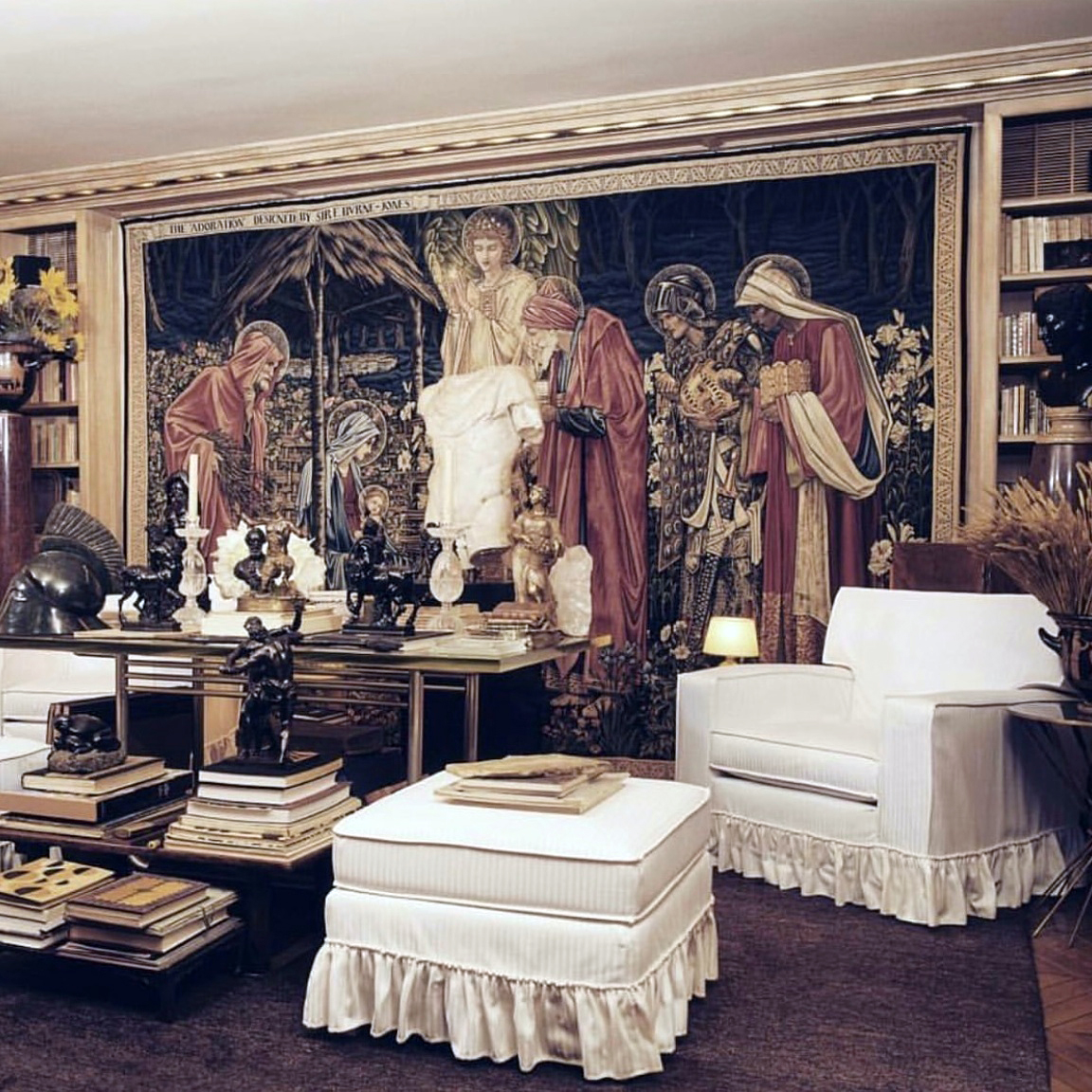Author: Taramis

I could not help but write about the history of my favorite tapestries after seeing the latest issue of Architectural Digest which features two separate homes- one in Menorca and the other in Venice with large scale tapestries by contemporary artist Yann Gerstberger.
The history of tapestry is a long one and can be traced back to ancient Greece, where the art of weaving also played an important part in mythology, such as in the story of Arachne, turned into a spider by the goddess Athena when she dared to create a superior tapestry. The earliest known tapestry weaving was done in linen by the ancient Egyptians between 1483 and 1411 BC. Preserved by the dry desert climate of Egypt, three tapestry fragments were found in the tomb of Thutmose IV.
From the Middle Ages to the Baroque, tapestries were far more expensive than paintings, and many frescoes tried to mimic the style of their more expensive woven counterparts. (Raphael's tapestries for the Sistine Chapel, for example, cost five times as much as Michelangelo's ceiling to produce, due to the gold thread and labor required to create them.) Tapestries appealed to an aristocratic audience as both decorative and functional objects that could be used to insulate rooms, and could also be rolled and moved easily between palaces. The subjects varied and some reflected contemporary aristocratic life in depictions of pastimes such as hunting.

The main weaving centers were ruled by the French Burgundian branches of the House of Valois, who were extremely important patrons in the Late Medieval period. Almost the only clear survival from these collections, and the most famous tapestry from the 14th century, is the huge Apocalypse Tapestry, a very large set made for Louis I, Duke of Anjou in Paris between 1377 and 1382. In 1373, at the height of the hundred years war and not long after the Black Death, Louis instructed Hennequin de Bruges, a Flemish painter to the court of King Charles V, to draw a group of miniatures from the final book of the Bible. His designs were then woven into 100 separate tapestries by the workshops of Nicolas Bataille and Robert Poincon using vivid red, blue and gold woolen thread. This epic work – the largest known medieval tapestry in the world – took nine years to complete but was kept in a chest and rarely shown. However, it was brought out, mounted on six wooden pedestals, for special occasions such as the marriage of Louis's son, Louis II of Anjou, to Yolande of Aragon at Arles in 1400. It marks the final battle between good and evil: Satan as a dragon and Christ as a lamb. Today you can see the tapestry in the Chateau d'Angers Museum.

Another set of famous tapestries dating back to the 15th Century is the Lady and the Unicorn. Five of the tapestries are commonly interpreted as depicting the five senses – taste, hearing, sight, smell, and touch. The sixth displays the words "À mon seul désir". The iconography of tapestries reflect the intellectual questions about senses. Each of the six tapestries depicts a noble lady with the unicorn. You can see this set of tapestries today in Paris at the Musee de Cluny.

The success of decorative tapestry can be partially explained by its portability (Le Corbusier once called tapestries "nomadic murals"). The fully hand-woven tapestry form is more suitable for creating new figurative designs than other types of woven textile, and the looms could be much larger. Kings and noblemen could fold up and transport tapestries from one residence to another. Many kings had "wardrobe" departments with their own buildings devoted to the care, repair, and movement of tapestries, which were folded into large canvas bags and carried on carts. In churches, they were displayed on special occasions. Tapestries were also draped on the walls of palaces and castles for insulation during winter, as well as for decorative display.
In the 19th century, the British designer William Morris (1834 – 1896) advocated for a return to
craftsmanship of the pre-industrial age, and sought to revive the art of tapestry. In his workshops at
Merton Abbey, Morris oversaw the production of the most celebrated tapestry series of his age: six
tapestries depicting the quest for the Holy Grail, which were woven between 1891 and 1894.
Morris had always had an interest in art, especially the works of the pre-renaissance era, but it was not
until he met painter Edward Burne-Jones that he began his creative quest to revive and preserve medieval art
forms. Burne-Jones, Morris, and other students founded the Pre-Raphaelite Brotherhood a group of artists
that looked to the art and culture of Middle Ages for inspiration. The Adoration of the Magi, a tapestry
made by Morris & Co to a design of Edward Burne-Jones, was hidden during the war by the family, who
eventually sold it to Yves St Laurent and Pierre Bergé. In 2009 Bergé donated it to the Musée d'Orsay.

A revived interest in the medium continued into the 20th century with the help of French patron of Modern tapestry Marie Cuttoli. Cuttoli recruited artists like Picasso and Man Ray to design textiles for her workshops in Algeria and shop in Paris, bringing Modernism to a broader audience in the early 20th century. When the Great Depression hit, Cuttoli moved the base of her weaving operation from Algeria to Aubusson, a historic weaving center suffering from an economic crisis, not far from her birthplace in central France. Tapestries were the most prized form of textile art, and Cuttoli saw a business opportunity in revitalizing an industry and art form. She commissioned designs from Lurcat and Georges Rouault, the latter of whom had worked in stained glass, another large-scale decorative medium. Collectors of these works included Helena Rubinstein and Nelson Rockefeller. By 1926, Cuttoli rebranded her shop as Galerie Myrbor, exhibiting works by Picasso, Braque, Marcoussis, Max Ernst, and other modern artists. To highlight the aesthetic affinities between decorative and fine art, she displayed rugs on the wall alongside the paintings.
After years of experimentation another revival of tapestry was instigated in the 1930s by the French painter and designer Jean Lurçat. was largely responsible for the revival and worked with François Tabard, master weaver at the Aubusson manufactory, to formulate a code of principles that would transform tapestry into a true collaboration between weaver and designer, and an art form in its own right, and in the second half of the 20th century tapestry attracted artists such as Jean Arp (1887 – 1966), Victor Vasarely (1906 – 1997), and Alighiero Boetti (1940 – 1994). When a selection of these tapestries toured the US in the 1930s and '40s, Cuttoli enjoyed the support of Dr. Albert Barnes, who was one of her most vocal advocates and patrons. Fittingly, the Barnes Foundation is the first major American institution to celebrate her visionary approach to art and business.

Another important tapestry I would like to mention is the 1946 Judith and Holofernes by Jean Cocteau at Villa Santo Sospir in the South of France. Surrounded by Madeleine Castaing's wicker walls and furniture, the crowning feature of the room is a magnificent tapestry on the back wall made by the famous Aubusson tapestry manufacturers. Cocteau designed the work and submitted the sketch to the manufacturers, who weaved the work over five years. The tapestry illustrates the story of Judith beheading Holofernes. Very much in love with the colors of this work, there is a softness in the colors even though the subject is far from peaceful.

